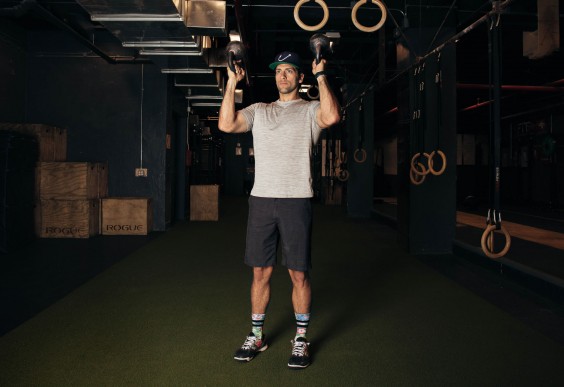Introduction
Fitness enthusiasts are always on the hunt for new and effective ways to improve their strength and endurance. One such technique that has gained popularity in recent years is the use of static holds in fitness training. Static holds, also known as isometric exercises, involve holding a position or pose without any movement of the joints.

Definition of Static Holds
Static holds are an exercise technique where a muscle or group of muscles contract and hold a position without any movement, typically for a specific amount of time. Unlike traditional weightlifting exercises that involve moving weights up and down, static holds require holding a position without any movement to maintain tension in the muscles.
Importance of Static Holds in Fitness Training
Static holds are an excellent way to supplement traditional weightlifting exercises. They can be used to target specific muscle groups that may not get activated during traditional lifts or enhance overall stability and balance. Additionally, static holds can help improve flexibility and increase range of motion over time.
Muscle Isolation
One significant benefit of static holds is their ability to isolate specific muscle groups effectively. For example, performing an isometric hold with your biceps helps activate more muscle fibers than just doing bicep curls alone. This increased activation can lead to improved strength gains when coupled with traditional weightlifting exercises.
Improved Stability and Balance
Static holds also help develop stability and balance by forcing you to engage more muscles than you would during regular weight lifting sets. By improving your overall stability, you decrease your risk of injury both inside and outside the gym.
Increased Flexibility

Static stretching can help improve flexibility over time when performed regularly at extended ranges where standard stretches don't seem as effective anymore. Stretching beyond these typical positions activates different receptors in your muscles leading towards greater gains in flexibility. Static holds are a valuable addition to any fitness program.

They can help improve muscle activation, balance, stability, and flexibility. In the following sections, we will discuss different types of static holds and how to perform them correctly for maximum benefit.
Types of Static Holds
Isometric Hold: The Foundation of Static Holds
Isometric holds are the most basic type of static hold. Bodybuilding Inner Circle involves holding a position for a set amount of time without any movement.
It is the foundation upon which all other types of static holds are built. When you perform an isometric hold, your muscles remain contracted, but there is no movement in your joints.
For example, one common isometric hold exercise is the plank, where you hold your body in a straight line with your forearms and toes on the ground for an extended period. Isometric holds are often used to improve stability and endurance as they require sustained muscle engagement.

Eccentric Hold: The Negative Side of Static Holds
An eccentric hold requires you to lower a weight slowly and under control, rather than lifting or holding it up. This type of static hold puts more emphasis on the eccentric or negative phase of movement, which can help create tension in your muscles that increases their strength. For instance, performing an eccentric bicep curl would require you to lift a dumbbell with both hands until it reaches shoulder level and then slowly lower it back down to starting position while maintaining tension throughout the lowering phase.

Concentric Hold: The Positive Side of Static Holds
A concentric hold emphasizes the positive phase of lifting weights by contracting your muscles against resistance without moving them through their full range of motion. Concentric holds are often included in training programs to help build muscle size and strength by focusing on specific areas.
For instance, performing a concentric squat would require you to hold at maximum contraction while standing up from squatting position without completing full range motion. Overall, incorporating different types of static holds into your workout routine can provide various benefits for improving muscular endurance and strength depending on what kind suits best according to your fitness goals.
How to Perform Static Holds Correctly?
Static holds are a great way to improve strength and stability, but it is essential to perform them correctly to maximize their benefits. The following paragraphs will discuss proper form and technique, duration and frequency, as well as progression and variation for static holds.
Proper Form and Technique
Proper form and technique are essential when performing static holds to target specific muscle groups effectively. Maintaining a good posture throughout the exercise ensures that the targeted muscles are engaged while avoiding unnecessary stress on other areas of the body.
It is important to keep your core tight throughout the hold while breathing evenly. Additionally, correct alignment of joints is crucial during static holds.
For example, when performing a plank hold, ensure that your elbows are positioned directly beneath your shoulders with your feet hip-width apart. Your spine should be in a straight line from head to heels.
Duration and Frequency
The duration and frequency of static holds vary depending on personal fitness goals. Beginners can start with short durations ranging from 20-30 seconds with intermittent breaks between sets for recovery before moving onto longer durations. More experienced individuals may choose to hold for up to 60 seconds or more per set.
Furthermore, the frequency at which you perform static holds varies depending on individual goals and fitness levels. Beginners may start with holding for 10-15 seconds at least three times per week while more experienced individuals may hold up their routine daily or multiple times in one day.
Progression and Variation
Progression is critical when incorporating static holds into one's workout routine. As you become more comfortable holding specific positions for longer periods of time, progressions such as adding weight or changing hand positions can be implemented into your routine. Variations also contribute significantly towards enhancing your overall performance; adding variations such as plyometric pushup variations or unilateral kettlebell holds can challenge your muscles further while targeting different muscle groups.
Performing static holds correctly is essential to maximize their potential benefits. By maintaining proper form and technique, gradually increasing hold durations and varying the exercise, individuals can improve strength, endurance, and overall athleticism effectively.
Muscle Groups Targeted by Static Holds
Static holds are a great way to target specific muscle groups in the body. The following sections will discuss which muscles are targeted during static holds and how these exercises can improve strength, endurance, and stability.
Upper Body Muscles
Static holds are a great way to target the upper body muscles. The most common upper body static hold exercise is the plank. This exercise targets the torso, shoulders, triceps, and chest muscles.
During a plank exercise, you hold your body in a straight line from your head to your heels while engaging your core and upper body muscles. Another upper body static hold exercise is the wall sit.
This exercise targets the quads, hamstrings, glutes, calves and back muscles. You start by standing with your back against a wall and slowly slide down until you’re in a seated position with your knees bent at 90 degrees.
Hold this position for as long as possible without allowing your knees to move forward beyond your toes. You can also perform static holds using dumbbells or kettlebells.
Hold them at shoulder level or above while keeping proper form and technique for an extended period of time. This will significantly improve overall arm strength.
Lower Body Muscles
Static holds can help increase muscle mass in lower extremities such as calves, quads hamstrings and glutes. A common lower-body static hold is called the calf raise hold or gastrocnemius hold that targets both soleus (a small flat muscle located under larger gastrocnemius) and gastrocnemius (larger calf muscle).
Stand on tip-toes with no support (wall or chair), then pause in an elevated position allowing weight distribution towards midfoot until fatigue sets in. Another effective lower-body static hold is called the squat hold where you keep yourself in a squat position for an extended period of time.
Similar to the wall sit, bend your knees at a 90-degree angle while keeping your back straight and your feet hip-width apart. Gradually increase the duration of the hold as you progress.
Core Muscles
Static holds are ideal for toning and strengthening core muscles such as abs, obliques and lower back muscles. A common exercise that targets the core muscles is called “The V-Sit” where you sit with knees bent and arms straight in front of you, then slowly raising both legs up until they reach as close to perpendicular line with floor as possible. Hold this position for a specific amount of time.
Another popular exercise that strengthens the abdominal muscles is called “the plank”.
This exercise targets both the upper and lower abs, as well as the obliques. In addition to plank variations such side planks or reverse planks, there are other effective static hold exercises designed to specifically target various areas of core muscles like Russian twists or bicycle crunches which can be performed using no equipment at all.
Advanced Techniques for Static Holds
Weight Vest or Resistance Bands: A Step Further
If you want to take your static holds to the next level, try adding weight vests or resistance bands. These additional weights create an extra challenge for your muscles, increasing the intensity of the exercise. When using a weight vest, start with a low amount of added weight and gradually increase as you progress.
Resistance bands can be used to target specific muscle groups and add varying degrees of difficulty depending on how tight they are. The use of additional weights also helps in building muscle mass and strength gains.
However, caution must be taken when using these advanced techniques as incorrect usage may lead to injuries. Make sure you have proper form and technique before incorporating these into your workout routine.
Unilateral or Asymmetrical Loading: Balancing Your Strengths and Weaknesses
Unilateral loading uses one limb at a time while asymmetrical loading involves using different weights for each side of the body. These two techniques create an imbalance in strength between sides which makes static holds more challenging. These techniques are particularly beneficial for individuals who have weaker limbs or muscles on one side compared to the other.
They help improve balance and coordination while also targeting specific areas in which there is weakness. Unilateral loading can be done with dumbbells, kettlebells, or even bodyweight exercises such as single-leg squats.
Plyometric Variations: Adding Explosiveness to Your Workouts

Plyometric variations involve adding explosive movements into static holds such as jumps or quick bursts of movement during the hold phase. These movements increase power output which results in improved athletic performance. For example, plyometric push-ups involve pushing explosively off the ground during a static hold at the bottom of a push-up position.
Plyometric variations require strong joints and connective tissues so it’s important to have a solid foundation of strength before attempting them. It’s also advisable to start with low intensity or shorter durations and gradually increase as you progress.
By incorporating these advanced techniques, you can take your static hold workouts to the next level and reap more benefits from your training. However, proper form and technique are crucial for safe execution so always consult with a fitness professional before adding these techniques into your routine.
Common Mistakes to Avoid When Performing Static Holds

Holding Breath During the Exercise
One of the most common mistakes people make when performing static holds is holding their breath. This mistake occurs when individuals try to maintain tension while holding their breath, which can result in poor oxygenation and decreased performance.
Holding your breath during a static hold can also cause an increase in blood pressure, which can be hazardous to your health. To prevent this from happening, make sure you breathe deeply and consistently throughout the entire exercise.
Focus on inhaling and exhaling slowly through your nose or mouth, depending on what feels most comfortable for you. This will help ensure that you're getting enough oxygen to your muscles and brain while also preventing any unwanted spikes in blood pressure.
Incorrect Posture or Alignment
Another common mistake people make during static holds is incorrect posture or alignment. Incorrect posture can lead to muscle imbalances, discomfort, fatigue, and even injury if left unchecked. To avoid this mistake, make sure that you have proper form during each static hold exercise.

Keep your spine straight and shoulders back as much as possible while engaging your core muscles throughout the entire duration of the exercise. Ensure that your feet are planted firmly on the ground with a slight bend in the knees if necessary depending on the exercise.
Not Focusing on the Targeted Muscle Group
Not focusing on the targeted muscle group is another common mistake people make during static holds exercises. It’s essential to focus solely on those muscles being worked by engaging them throughout each repetition. For example: individuals performing a plank should focus mainly on contracting their abdominal muscles instead of just holding themselves up with their arms for an extended period without actually engaging their core muscles properly.
To avoid this mistake: always stay focused during each repetition of every set performed and visualize contracting only those targeted muscle groups. Also, you can consider hiring a personal trainer to provide guidance and feedback on proper form and technique during static holds exercises.
Conclusion: Why You Should Incorporate Static Holds into Your Workout Routine?
Improves Strength, Endurance, and Stability
Static holds are one of the most effective ways to improve your strength, endurance, and stability. Holding a static position for a prolonged period of time places a constant demand on your muscles, forcing them to work harder and adapt accordingly.
This results in increased muscular strength and endurance over time. Moreover, incorporating static holds into your workout routine can also improve your overall stability by enhancing neuromuscular control and coordination between muscle groups.
By incorporating isometric holds into your workout routine, you can target specific muscles that may not be effectively targeted with traditional weightlifting exercises. For example, holding a plank position targets the deep core muscles that play a vital role in maintaining spinal stability and preventing lower back injuries.
Reduces Risk of Injury

In addition to improving strength and endurance, static holds also help reduce the risk of injury during physical activity. In fact, research has shown that incorporating isometric exercises into rehabilitation programs can significantly reduce the likelihood of reinjury.
Furthermore, by incorporating static holds into your workouts you can strengthen weak areas in your body which may have been neglected through traditional training methods. This will help prevent muscle imbalances which are often associated with overuse injuries such as tendinitis or strain injuries.
Enhances Overall Athletic Performance
Including static holds in your workout routine can enhance overall athletic performance by improving balance, flexibility and posture. Static holds require significant amounts of muscular tension which helps increase blood flow to the working muscles resulting in improved nutrient delivery and waste removal. Improved flexibility is another benefit associated with static hold training as it increases range of motion around joints through an increased tolerance to stretch receptors within our musculature system resulting in better mobility within those joints.
Overall there are many reasons why static holds should be included in your workout routine. By improving strength, endurance and stability while reducing the risk of injury and enhancing overall athletic performance, static holds should be considered an essential training tool for any fitness enthusiast or athlete looking to get the most out of their workouts.
